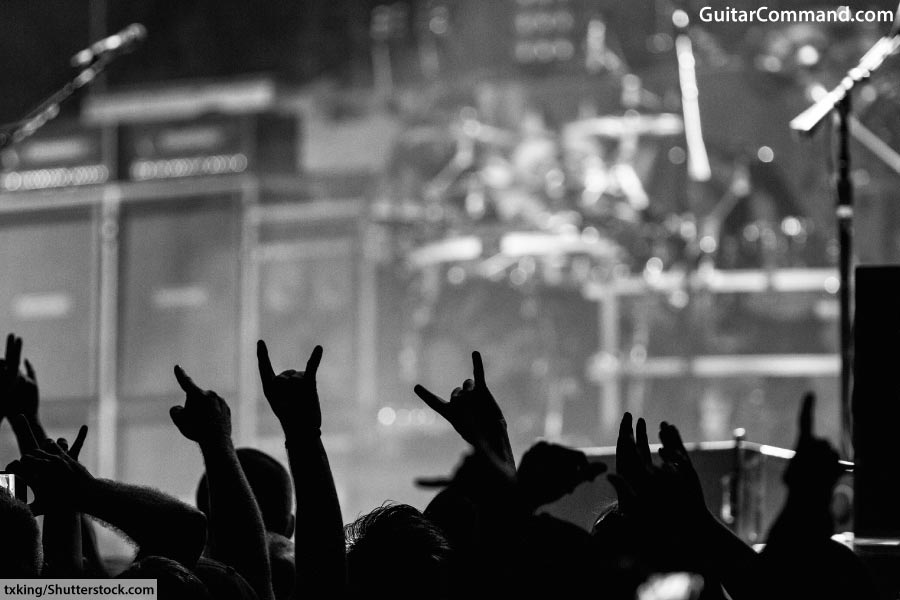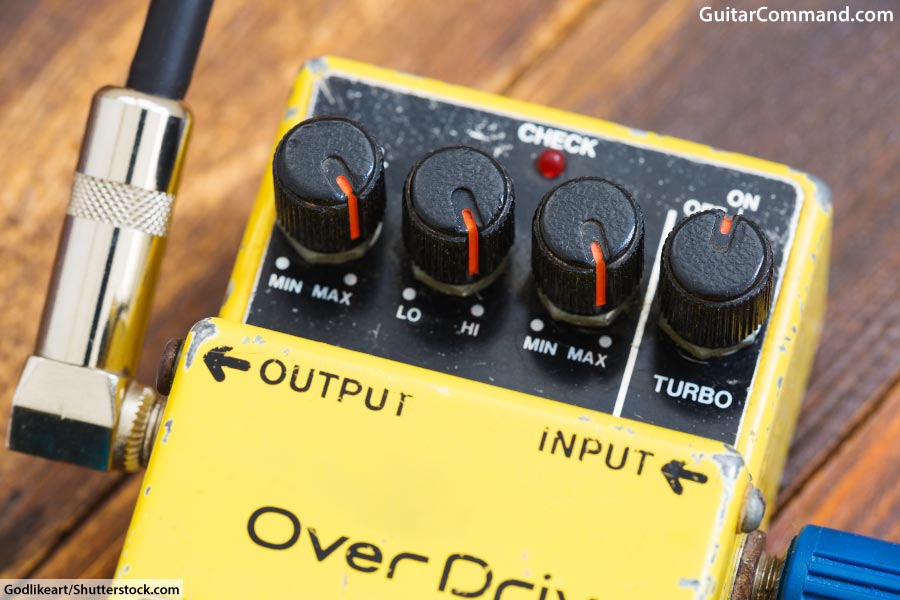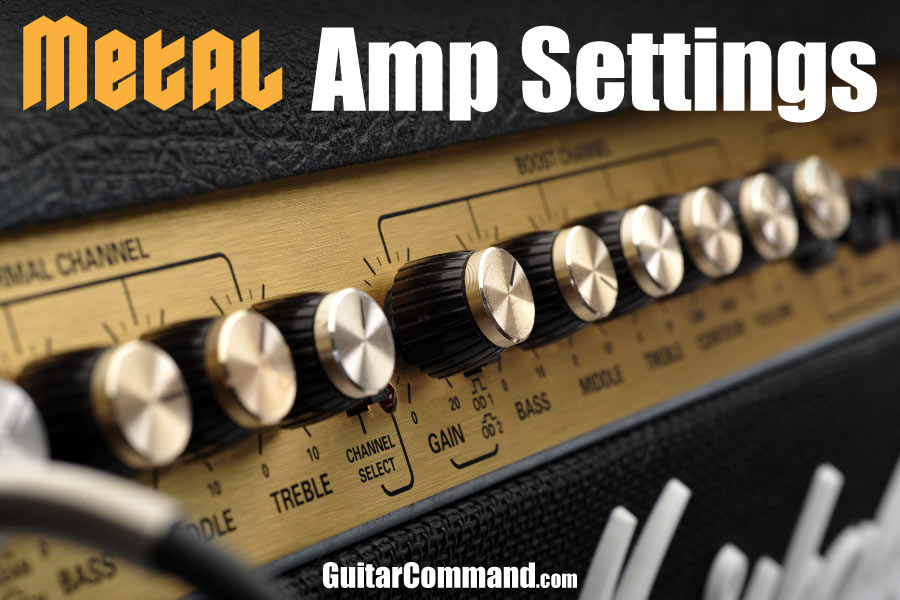Metal amp settings – a complete guide on how to set up your guitar amplifier to create a range of metal tones.
It's possible to spend thousands of dollars in the quest for the perfect metal guitar sound, but often just a few simple tweaks to your existing amp settings is all it takes to change a mediocre tone into a metal sound you can be proud of.
Getting a good metal sound can be a challenge, but it’s not impossible, whatever gear you own.
Page Index
- How To Get A Good Metal Tone?
- Basic Metal Amp Settings
- Hard Rock Amp Settings
- Classic/Trad Metal Amp Settings
- Thrash Guitar Amp Settings
- Nu Metal Amp Settings
- How Your Gear Affects Your Tone
- What Pick Is Best for Metal?
- Double Tracking Guitar Parts
- Conclusion
How To Get A Good Metal Tone

In this article, we’re looking at the key ingredients that make for a good, powerful metal guitar sound and share example amp settings to help you achieve your dream metal tone.
It will help if you have a guitar built for the job (that usually means a solid body guitar fitted with humbuckers), but, for the purpose of this page, the main consideration is the amp. It's perfectly possible to get a good metal sound with virtually any guitar.
You can see some great metal guitars on this page: Best Guitars For Metal: Features You Need, Recommended Brands & Models
Most guitar amplifiers tend to have very similar control layouts. As a general rule, you’ll have control knobs for:
- Gain (to control the level of saturation and distortion)
- Volume (to control the overall loudness)
- EQ (typically divided into bass, midrange, and treble)
How you set these levels has a huge impact on your tone. Great metal tone requires a combination of the following:
- Distortion and saturation
- Powerful, chugging bottom end
- Enough clarity to hear the notes being played, especially for riffs and solos
Balancing these requirements is a lifelong journey. In this article, we’ll look at a broadly applicable metal tone as well as some tones tailored to more specific genres.
We’ll also clarify if you will need any extra gear, like a distortion pedal, to achieve true tonal bliss.
You can see some of the best pedals for metal on this page: Guitar Pedals For Metal
Be aware that different amps will respond to different settings in their own unique way, and setting up your amp will require some trial and error – use the suggested amp settings below as a basis for achieving the tone you want.

Basic Metal Amp Settings
The settings below will give you a good, solid metal tone. We encourage you to start with these amp settings and tweak to your own preferences.
(Each number is out of ten.)
- Gain: 7
- Treble: 7
- Mids: 3
- Bass: 7
- Volume: 5
These settings will give you the high-gain “scooped mids” tone that many players expect from metal guitar.
Depending on your amp, the above settings should give you enough definition – thanks to your boosted bass and treble frequencies – with plenty of thick, saturated chunkiness to complement the top-end bite.
Many amps have resonance and presence controls. These mostly affect how “far away” your amp sounds in the room, and are not major factors in determining your overall tone. If your amp has either (or both), then set them to neutral – usually about 5 – and adjust to taste.
Think of resonance and presence as icing, while volume, gain, and EQ are the cake itself.
It’s important to note here that the volume and gain knobs on different amplifiers will interact with each other in different ways.
Sometimes, cranking your gain but not the volume results in a tinny, fizzy tone.
In a tube amplifier, the volume knob adds poweramp saturation, which is the underlying layer of distortion responsible for the authoritative, powerful tone of many classic metal records.
Modern solid-state and modelling amps do not depend on poweramp saturation in the same way.
Hard Rock Amp Settings
As a source of inspiration for our classic hard rock tone, we’re turning to Guns N’ Roses’ seminal debut album Appetite for Destruction and the slinky, snarling tone of lead guitarist Slash. You’ll notice that Slash’s tone on GN’R classics like “Nightrain” and “Welcome to the Jungle” is thick, articulate, and almost vocal-like in its delivery. This comes thanks to the high midrange in the EQ and the relatively low gain.
- Presence: 5
- Bass: 7 (if you’re using a Marshall or similar treble-heavy amp - otherwise bring down to about 5)
- Mids: 6
- Treble: 5
- Volume: 6 or higher
- Gain: 3 (tweak depending on your guitar)
For classic hard rock, you want the squeaks and scrapes of your pick hitting the string to be audible. Dynamic variation between notes that are picked harder or softer are a major facet of the hard rock player’s tonal arsenal. We’ve included enough gain to give this tone plenty of push, but much of this tone’s blatant badassery comes from poweramp saturation.
It doesn’t chug, but it sure does sing.
This is a great tone for classic radio-ready hard rock riffage.
Use these settings when you play Aerosmith, Guns N’ Roses, or KISS riffs. The louder, the better.
Classic/Trad Metal Amp Settings
We’ve based these settings on classic early eighties metal sounds: those of Dave Murray and Adrian Smith of Iron Maiden; and Ozzy Osbourne’s legendary axeman Randy Rhoads.
There’s more preamp “fizz” and gain than on the hard rock tone because this style requires more aggressive palm muting and distortion. Similarly, you’ll notice that although the mids are boosted a little, we’ve cut back on the bass frequency to prevent things from getting too muddy.
- Gain: 6-7
- Bass: 4
- Mids: 6-7
- Treble: 4-6
- Volume: 5-6
To really get the most out of this tone, however, you will need a distortion pedal to give your amplifier some extra front-end push.
Dave Murray, Adrian Smith, and Randy Rhoads all used the MXR Distortion Plus. That’s an inexpensive, user-friendly pedal perfect for this sort of music. Switch it on when it’s time to tear through the solo from “Crazy Train”.
Use these settings when you play Iron Maiden, Dio, or Judas Priest.
Thrash Guitar Amp Settings
We’ve based these settings on the chunky, red-hot guitar tone of thrash metal’s Big Four: Metallica, Megadeth, Anthrax, and Slayer.
- Gain: 6
- Mids: 1-2
- Bass: 8
- Treble: 8
- Volume: 5 or higher
Thrash metal is defined by rapid-fire bottom-E palm muting, contrasted against frenzied riffs and licks played on the upper strings.
Accordingly, the tone you need lacks the “vocal” quality of mid-heavy early 80s metal, instead leaning into the “scooped” sound. The trick here is having a high-gain signal without allowing it to become “mushy” and undefined.
Be prepared to further tweak your settings from these guidelines to get the ultimate thrash tone.
This tone should be nasty, authoritative, and powerful.
Use these settings when playing classic 80s thrash and death metal.
Nu Metal Amp Settings
For the tight, full, tone of nu-metal, these settings work a treat. We’ve based this on classic Korn, Limp Bizkit, and Papa Roach. This guitar tone is a little more refined than the full-bore nastiness of the thrash sound, but with plenty of chunky saturation for playing those highly syncopated, downtuned riffs.
- Gain: 6
- Treble: 5
- Mids: 6
- Bass: 5
- Volume: 4
Nu-metal playing places a greater emphasis on rhythm rather than complexity or musicianship. Generally speaking, you won’t be playing guitar solos as you would in other metal genres, so you don’t need as much cut and bite in the tone.
Unless you’re using a very high-gain amp, you’ll probably need a distortion or overdrive pedal to boost and fatten your tone for this type of music.
Use these settings when you’re playing songs by Limp Bizkit, Slipknot, or Korn.
How Your Gear Affects Your Tone

Your choice of equipment has a massive impact on your guitar tone. Generally speaking, metal guitar demands an appropriate amplifier, usually one with a discrete gain control and master volume.
Marshall’s JCM series, that is the JCM800, 900, and 2000, are all classic metal amplifiers. Other great metal amp brands include:
- Diezel
- Revv
- Mesa Boogie (specifically a dual rectifier)
- Peavey 6505
- EVH
Beyond that, you might want to consider using some type of boost. This is a personal preference, depending on the genre of metal you’re playing. Zakk Wylde, of Black Label Society and Ozzy Osbourne, used a simple Boss overdrive pedal in front of a cranked Marshall amp to achieve his incendiary lead tone.
Metallica’s Kirk Hammet often deployed an Ibanez Tube Screamer and a heavy dose of wah-wah to add some color and flavor to his solos.
You could try for a clean boost, simply to increase the volume of your playing for solos, or a classic distortion pedal like the Boss DS-1 or the Proco Rat.
The best thing to do, however, is to start with amp settings that work for you, and add pedals on top of that.
You can see a suggested list of pedals for metal on this page: Guitar Pedals For Metal
What Pick Is Best for Metal?
As a general rule, you’ll want a thicker guitar pick for playing metal. Thicker picks have less bend to them, essentially allowing you to play faster. This is most helpful when you’re playing rapid alternate-picked or downpicked guitar licks.
While many players use the standard rounded teardrop pick shape, some guitarists prefer to file their guitar pick down to a point. The Dunlop Jazz III shape also has a pointed end.
Picks with a sharper edge make playing fast, brutal metal guitar easier and have a more clearly define tone than rounded picks.
Double Tracking Guitar Parts For Metal
One oft-used trick for creating a powerful metal guitar sound is to use double tracking. Obviously, this is a studio, rather than a live, effect. It involves the exact same guitar part being recorded two (or more) times. This serves to thicken the sound, making it more powerful.
When double tracking, great skill is required to play the part in exactly the same way in each take. Slight variations in timing will muddy the sound, rather than making it more powerful. You can also experiment by playing one track with the bridge pickup and the other with the neck pickup – or even using different guitars for each take.
Conclusion
While a good metal guitar tone is subjective, you can use the amp settings above as a basis to getting a guitar sound you can be proud of. Never be frightened to tweak your amp settings. Experimenting with gear you own should always be the first thing you try before rushing out to get the latest piece of gear.
How do you get your metal guitar tone? Have you got any amp settings or gear choices you want to share? Let us know in the comments below!


